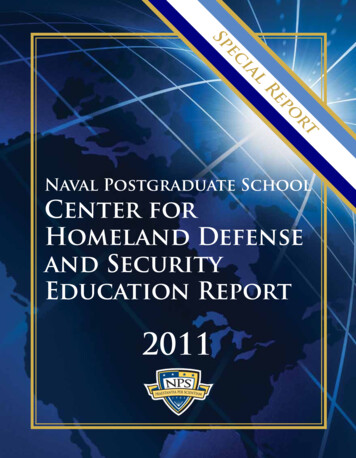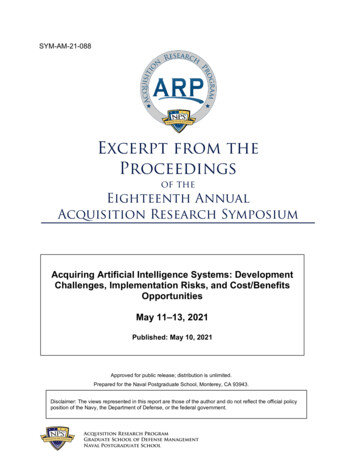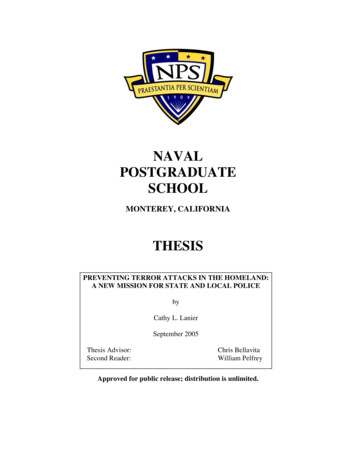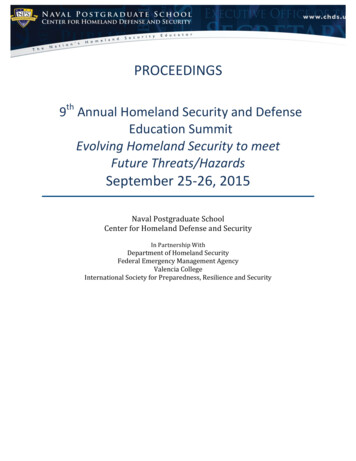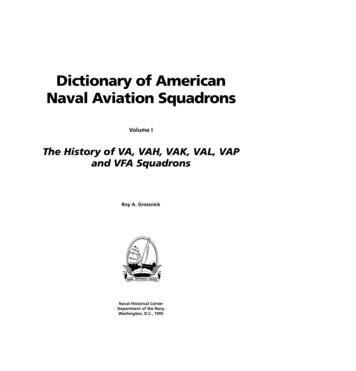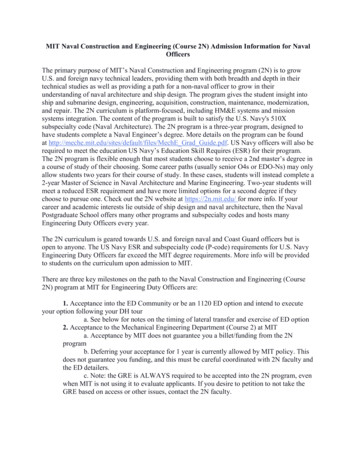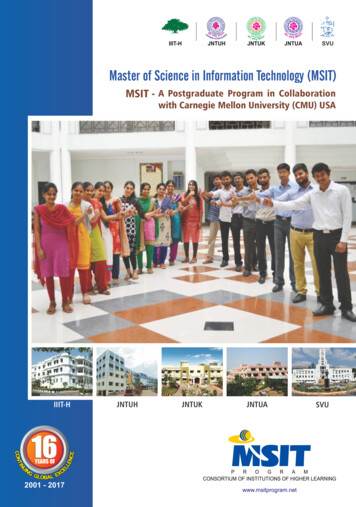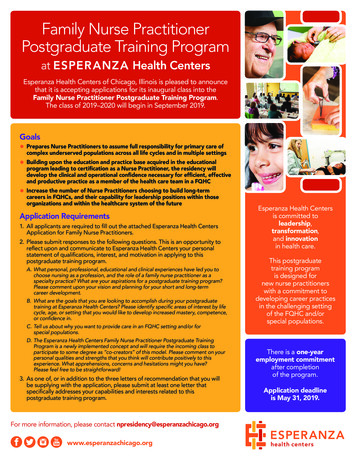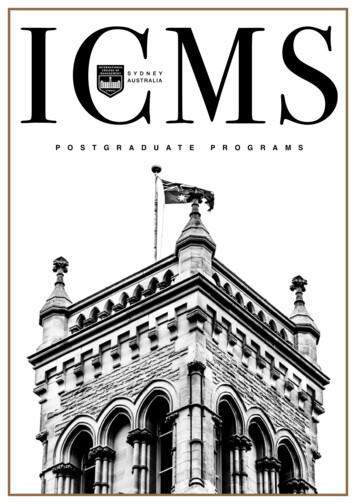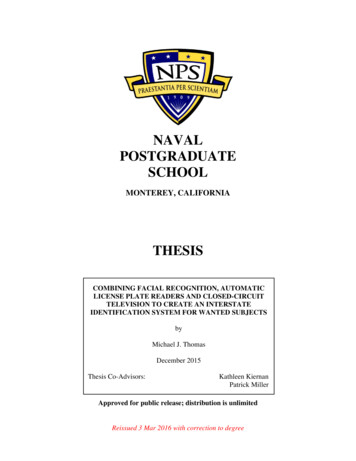
Transcription
NAVALPOSTGRADUATESCHOOLMONTEREY, CALIFORNIATHESISCOMBINING FACIAL RECOGNITION, AUTOMATICLICENSE PLATE READERS AND CLOSED-CIRCUITTELEVISION TO CREATE AN INTERSTATEIDENTIFICATION SYSTEM FOR WANTED SUBJECTSbyMichael J. ThomasDecember 2015Thesis Co-Advisors:Kathleen KiernanPatrick MillerApproved for public release; distribution is unlimitedReissued 3 Mar 2016 with correction to degree
THIS PAGE INTENTIONALLY LEFT BLANK
REPORT DOCUMENTATION PAGEForm Approved OMBNo. 0704–0188Public reporting burden for this collection of information is estimated to average 1 hour per response, including the time for reviewinginstruction, searching existing data sources, gathering and maintaining the data needed, and completing and reviewing the collectionof information. Send comments regarding this burden estimate or any other aspect of this collection of information, includingsuggestions for reducing this burden, to Washington headquarters Services, Directorate for Information Operations and Reports, 1215Jefferson Davis Highway, Suite 1204, Arlington, VA 22202-4302, and to the Office of Management and Budget, PaperworkReduction Project (0704-0188) Washington, DC 20503.1. AGENCY USE ONLY2. REPORT DATE3. REPORT TYPE AND DATES COVEREDDecember 2015Master’s thesis(Leave blank)4. TITLE AND SUBTITLE5. FUNDING NUMBERSCOMBINING FACIAL RECOGNITION, AUTOMATIC LICENSE PLATEREADERS AND CLOSED-CIRCUIT TELEVISION TO CREATE ANINTERSTATE IDENTIFICATION SYSTEM FOR WANTED SUBJECTS6. AUTHOR(S) Michael J. Thomas7. PERFORMING ORGANIZATION NAME(S) AND ADDRESS(ES)Naval Postgraduate SchoolMonterey, CA 93943-50009. SPONSORING /MONITORING AGENCY NAME(S) ANDADDRESS(ES)N/A8. PERFORMINGORGANIZATION REPORTNUMBER10. SPONSORING /MONITORING AGENCYREPORT NUMBER11. SUPPLEMENTARY NOTES The views expressed in this thesis are those of the author and do not reflect theofficial policy or position of the Department of Defense or the U.S. Government. IRB Protocol number N/A .12a. DISTRIBUTION / AVAILABILITY STATEMENTApproved for public release; distribution is unlimited13. ABSTRACT (maximum 200 words)12b. DISTRIBUTION CODEAdvancing technology in the field of facial recognition systems (FRS), closed-circuit television(CCTV) and automatic license plate readers (ALPRs) could make it possible to create a system capable ofidentifying suspected terrorists, current terrorist watch list suspects, other wanted criminals, and missingpersons. This research examines the convergence of these technologies to design an efficient system andimprove the speed and accuracy of potential suspect identification. To do so, the thesis examines allsystems’ basic capabilities, privacy issues or concerns, best practices, possible areas for improvement, andpolicy considerations.Since the tragedies of September 11, 2001, a large volume of literature related to FRS, ALPR, andCCTV systems has been created. The intent of this thesis is to serve as catalyst for a new security systemdesigned to locate, identify, and apprehend known terrorist watch list suspects and other wanted personswho are traversing the interstate systems in the United States. The goal is to provide another layer ofprotection and create a deterrent to both criminal and terrorist activity, providing a safer environment forall U.S. citizens. Furthermore, this capability can help locate Amber Alert and Silver Alert subjects.14. SUBJECT TERMSFacial recognition, automatic license plate readers, closed-circuit television, technology, watchlist, databases, combined technologist, terrorist identification, Amber Alert, Silver Alert,interstate identification system, London City, OCR reader, photographic database, license platedatabase, Patriot Act, REAL ID17. SECURITY18. SECURITY19. SECURITYCLASSIFICATION OFCLASSIFICATION OF THISCLASSIFICATIONREPORTPAGEOF ABSTRACTUnclassifiedUnclassifiedUnclassifiedNSN 7540–01-280-550015. NUMBER OFPAGES10116. PRICE CODE20. LIMITATIONOF ABSTRACTUUStandard Form 298 (Rev. 2–89)Prescribed by ANSI Std. 239–18i
THIS PAGE INTENTIONALLY LEFT BLANKii
Approved for public release; distribution is unlimitedCOMBINING FACIAL RECOGNITION, AUTOMATIC LICENSE PLATEREADERS AND CLOSED-CIRCUIT TELEVISION TO CREATE ANINTERSTATE IDENTIFICATION SYSTEM FOR WANTED SUBJECTSMichael J. ThomasMajor, Florida Highway PatrolB.P.A., Barry University, 2006Submitted in partial fulfillment of therequirements for the degree ofMASTER OF ARTS IN SECURITY STUDIES(HOMELAND SECURITY AND DEFENSE)from theNAVAL POSTGRADUATE SCHOOLDecember 2015Approved by:Kathleen KiernanThesis Co-AdvisorPatrick MillerThesis Co-AdvisorErik DahlAssociate Chair or InstructionDepartment of National Security Affairsiii
THIS PAGE INTENTIONALLY LEFT BLANKiv
ABSTRACTAdvancing technology in the field of facial recognition systems (FRS), closedcircuit television (CCTV) and automatic license plate readers (ALPRs) could make itpossible to create a system capable of identifying suspected terrorists, current terroristwatch list suspects, other wanted criminals, and missing persons. This research examinesthe convergence of these technologies to design an efficient system and improve thespeed and accuracy of potential suspect identification. To do so, the thesis examines allsystems’ basic capabilities, privacy issues or concerns, best practices, possible areas forimprovement, and policy considerations.Since the tragedies of September 11, 2001, a large volume of literature related toFRS, ALPR, and CCTV systems has been created. The intent of this thesis is to serve ascatalyst for a new security system designed to locate, identify, and apprehend knownterrorist watch list suspects and other wanted persons who are traversing the interstatesystems in the United States. The goal is to provide another layer of protection and createa deterrent to both criminal and terrorist activity, providing a safer environment for allU.S. citizens. Furthermore, this capability can help locate Amber Alert and Silver Alertsubjects.v
THIS PAGE INTENTIONALLY LEFT BLANKvi
TABLE OF CONTENTSI.INTRODUCTION.1A.PROBLEM STATEMENT .1B.RESEARCH QUESTIONS AND CONSIDERATIONS .2C.PRACTICAL SIGNIFICANCE OF THE RESEARCH .4D.METHODOLOGY .6E.THESIS ORGANIZATION .7II.BACKGROUND .9A.FACIAL RECOGNITION .9B.LAW ENFORCEMENT USE OF FACIAL RECOGNITIONTECHNOLOGY .12C.CLOSED-CIRCUIT TELEVISION (CCTV) .141.United Kingdom CCTV Model .152.The United States’ Use of CCTV .19D.AUTOMATED LICENSE PLATE READER (ALPR)TECHNOLOGY .21E.LEGAL CHALLENGES FOR FACIAL RECOGNITION .22F.LEGAL CHALLENGES FOR AUTOMATIC LICENSEPLATE READERS (ALPRS) .25G.PUBLIC ACCEPTANCE AND CCTV .27H.TECHNICAL CONCERNS .27I.NOTABLE SUCCESSES .29III.LITERATURE REVIEW .35A.TECHNOLOGY .371.Current Capabilities of Facial Recognition Systems (FRS) .372.Current Capabilities of Automatic License Plate Readers(ALPR) .373.Current Capabilities of Closed-Circuit Television(CCTV).39B.DATABASE CAPABILITY FOR FRS, ALPR AND CCTV .39C.INTERSTATE HIGHWAY DESIGN (CURRENT SYSTEMSAND EXISTING INFRASTRUCTURE) .40D.LEGAL REVIEW AND POSSIBLE CHALLENGES .411.Civil Liberties Groups .412.Court Cases.44E.PROCESSES .45vii
IV.ANALYSIS .47A.LEGAL CONSIDERATIONS .48V.CONCEPTUAL MODELING—HIGHWAY FRS/ALPRAPPREHENSION SYSTEM .51A.TECHNICAL CONSIDERATIONS .52B.CONCEPT .531.Control Center/Room .532.CCTV, ALPR Camera Placement .553.Database .554.Scrubbing .57C.SYSTEM DESIGN .57D.BENEFITS .59VI.RECOMMENDATIONS .61VII.CONCLUSION .67APPENDIX. .69LIST OF REFERENCES .75INITIAL DISTRIBUTION LIST .83viii
LIST OF FIGURESFigure 1.Research Cycle.6Figure 2.Worldwide CCTV Systems Ranking .16Figure 3.Facial Recognition/ALPR System on Interstate System .58ix
THIS PAGE INTENTIONALLY LEFT BLANKx
LIST OF TABLESTable 1.Wanted Subjects and Warrants .31Table 2.Silver Alert Calls.31Table 3.Amber Alert Calls .32Table 4.Control Center Projected Staff Requirements.54Table 5.Control Center Projected Recurring Annual Costs .54Table 6.Stakeholders for System Implementation .64xi
THIS PAGE INTENTIONALLY LEFT BLANKxii
LIST OF ACRONYMS AND ABBREVIATIONSACLUAmerican Civil Liberties UnionALPRautomatic license plate readersBOLObe on the lookoutCCTVclosed-circuit televisionCIACentral Intelligence AgencyDAVIDDriver and Vehicle Information DatabaseDHSMVDivision of Highway Safety and Motor VehiclesEFFElectronic Frontier FoundationFBIFederal Bureau of InvestigationFCIC/NCICFlorida Crime Information Center and National Crime InformationCenterFIOAFreedom of Information ActFRSfacial recognition systemFRVTFace Recognition Vendor TestIACPInternational Association of Chiefs of PoliceIAFISIntegrated Automated Fingerprint Identification SystemINSImmigration and Naturalization ServiceIRAIrish Republican ArmyLPRlicense plate readerMOUmemorandum of understandingNGINext Generation Identification ProgramNISTNational Institute of Standards and TechnologyNSSENational Special Security EventsOCRoptical character recognitionPIIpersonally identifiable informationxiii
THIS PAGE INTENTIONALLY LEFT BLANKxiv
ACKNOWLEDGMENTSI would like to take this opportunity to thank my wonderful wife, Maria, foralways being there for me over the past 31 years and providing me the love, support andunderstanding that has allowed me to take on several challenges in life, both professionaland personally. I would also like to extend thanks to my wonderful children, Nicole,Michael and Natalie, for sharing in this journey and being the rocks that hold ourfoundation together.My sincere thanks to the Florida Highway Patrol and Retired Colonel DavidBrierton for allowing me the opportunity to attend this institution, which in turn hasallowed me to gain a wealth of knowledge and understanding that I can bring back andshare within our agency. Special thanks to Chief Cyrus Brown for his continued supportand guidance, and for helping me gain the approval needed to attend this institution andexperience a level of education that is truly astonishing.I am extremely grateful to the Naval Postgraduate School and the Center forHomeland Defense and Security for providing me this opportunity and affording me achance to gain valuable knowledge, which I can put to use to provide better security forthose citizens under my purview.I would like to acknowledge and thank the extraordinary cadre of NPS instructors,facilitators, staff and my two main thesis advisors, Kathleen and Patrick, for helping memake this experience so rewarding.Finally, to the men and women of the Florida Highway Patrol who are on thefront lines every day protecting and serving in an attempt to keep the public safe: I amtruly grateful for your support and extremely proud of the work you do day in and dayout to provide safety and security to our communities. It is an honor to serve with you,and I look forward to continuing our relationship and working hard together to provideample security for all.xv
THIS PAGE INTENTIONALLY LEFT BLANKxvi
I.A.INTRODUCTIONPROBLEM STATEMENTSince September 11, 2001, there has been an emergence of activity surroundingterrorist groups such ISIS and Boko Haram, and the ever-present threat of Al Qaeda,along with countless homegrown terrorist groups that support their activities. Thesegroups have increasingly called on their followers to stage attacks against the UnitedStates. Even though Timothy McVeigh and Mohammad Atta where both listed as personsof interest on the U.S. Terrorist Watchlist, they were able to avoid detection and carriedout their attacks against the United States. Prior to September 11, this watch list wasrelatively unheard of, even though law enforcement agencies have maintained similarlists for years. The unique difference, however, between pre-9/11 watch lists maintainedby individual agencies and today’s Terrorist Watchlist is the cooperative sharing ofinformation that now exists across the law enforcement community. 1 This previous lackof sharing and the ability to find suspects quickly put Americans at risk each day; The9/11 Commission Report cited the lack of information sharing between intelligencecollection and law enforcement agencies as a key component in the success of the WorldTrade Center and Pentagon attacks. 2If the United States is to successfully thwart future attacks, it will require a systemor process that can quickly identify these suspects and lead to their apprehension at theearliest intervention opportunity. In moving forward and reviewing technology that couldaid in the detection of suspected terrorist and wanted suspects—to include the combiningof facial recognition systems (FRS), automatic license plate readers (ALPR), closedcircuit television (CCTV) and/or similar technology—several obstacles will have to beovercome. Some civil liberties groups may consider the convergent use of thesetechnologies as a threat to privacy and their intentional use absent probable cause. One of1 Katie Rucke, “‘Startling’ Number of Americans are on Terrorist Watchlist,” Mint Press News, Jully23, 2014, mericans-are-on-terrorist-watchlist/194356.2 Thomas Kean, The 9/11 Commission Report: Final Report of the National Commission on TerroristAttacks upon the United States (Washington, DC: Government Printing Office, 2011).1
the technologies these groups are concerned with is facial recognition, also known as abiometric. The term biometrics refers to “technologies that measure and analyse humanphysiological or behavioral characteristics for authentication or identification purposes”;biometrics often rely on identifiers such as fingerprints and voice patterns. 3Civil liberties groups like the Electronic Frontier Foundation and the AmericanCivil Liberties Union (ACLU) fear that the collection of photographic images for facialrecognition and other personally identifiable information (PII)—which can be collectedon a subject from a distance, in open spaces, without probable cause—for people whohave no connection to criminality or terrorism could be a violation of the FourthAmendment right to privacy. These fears surround the notion that, by collecting largesamplings of photographic images of a subject and his or her surroundings, one couldessentially assimilate identify a person’s travels, and even their religious and politicalaffiliations, which are protected by privacy laws; however, no successful challenges havebeen made thus far. Since technology does have limitations, additional research wouldhave to be conducted to determine capabilities to include strengths, weaknesses,adaptability, functionality, accuracy and feasibility to identify the best systems to meetthe specific goal outlined. One other area of concern would be the capturing, sharing andretention of records associated with protected information. Policies will have to bedeveloped that support the use of this technology and cover all issues related to itsdeployment, including records retention.B.RESEARCH QUESTIONS AND CONSIDERATIONSCan facial recognition, closed-circuit television and automatic license platereaders be combined to develop a single interstate identification system that can be usedto detect suspected terrorists and wanted suspects, and/or locate missing children andelderly persons? If so, what regulatory concerns and privacy or policy considerationsmust be addressed for successful implementation of this system? What agencies or3 “Biometrics,” Biometric-Solutions, accessed November 27, 2015, http://www.biometricsolutions.com/index.php.2
entities would have to come together under a memorandum of understanding (MOU) orother binding construct to allow for the successful deployment of these systems?There are currently no systems that combine these three technologies to capturewatch list subjects. This thesis seeks to determine if they can, indeed, be combined into afeasible investigative tool. To do so, this research defines the minimum capabilities ofFRS ALPR and CCTV, and assesses their projected capabilities as technology continuesto improve. Additionally, this research evaluates existing independent policies for thesetechnologies that may reveal a best practice scenario and guide policy for the combinedtechnologies. This leads to an assessment of data collection and security considerations,focused on determining how the data from these systems could be collected andmaintained. The research also recommends an assessment to determine if the system’santicipated added security for homeland security is worth the cost of its implementationAs noted, in developing comprehensive policy, rules and procedures for the use ofthese combined technologies, there must be an assurance of privacy and civil libertyprotection throughout the required biometric processes (collecting, matching, storing,managing and sharing data) and the operational/business processes. 4 How shouldagencies develop best practices for collecting, storing and sharing images acrossplatforms, which can include state, local, tribal, federal and commercial entities, whilemaintaining public trust through transparency of operations? Several civil liberties groupshave already begun collecting information to challenge the legality of using thisequipment, claiming that it violates a person’s right to privacy. Privacy fears have oftenled to policies that can unintentionally or purposely hinder potentially beneficialtechnologies. For example, “U.S. policymakers have delayed the adoption of variouspublic sector technologies, from smart meters to electronic identification, in part becauseof the pushback these technologies have received from privacy advocates.” 5 In4 FBI, Striking a Balance—A Government Approach to Facial Recognition Privacy and Civil Liberties(U.S. Government Facial Recognition Legal Series Forum 2) (Washington, DC: Department of Defense,2012).5 For example, activists have delayed the adoption of smart meters that measure energy usage inNevada. See “Power Struggle: Customers vs. NV Energy Smart Meters,” Fox 5 Las Vegas, February 6,2015, debate-customers-vs-nv-energy-smart-meters.3
embracing technology, however, we must also embrace changes to life patterns that thetechnology may bring. As humans, we tend to fear that which we do not know and acceptthat which is familiar. “A ‘mass moral panic’ occurs when one section of society distrustsor fears the choices made by others and believes these choices pose a risk to the societyas a whole.” 6 There must be a recognition that technology is evolving so fast that thegeneral public and legal system may not be able to keep up; while there are no currentcivil actions filed, the need exists to develop and formulate policy that can withstandlegal challenges and public scrutiny.C.PRACTICAL SIGNIFICANCE OF THE RESEARCHSurveillance systems are continually improving as technological advancementsare made. Improvements can be found in technology used to distinguish one face fromanother (as in facial recognition), optical character recognition (OCR) readers thatdistinguish characters on tags in ALPRs, and CCTV systems that utilize high-definitioncameras, producing images that can be imported into FRS over the Internet, or via bluetooth or WIFI connections. As these systems improve, so does their capability to scan andcapture images of suspects and vehicles as they pass, allowing these samples to beanalyzed against shared images in many databases, including those of state motor vehicledepartments, Department of Corrections, Department of Homeland Security, Customsand Border Protection, Federal Bureau of Investigation (FBI), National SecurityAdministration and other governmental agencies that use biometrics or house vehiclelicense information.The intent of this thesis is to serve as a catalyst for the formation of a new securitysystem designed to locate, identify and apprehend known terrorist watch list suspects andother wanted persons who are traversing the interstate systems in the United States,adding another layer of homeland security protection. These persons of interest currentlymove freely across the interstate system in the United States, often escaping courtordered sanctions and allowing possible terrorist attacks against U.S. citizens or6 Adam Thierer, “Techno-Panic Cycles (and How the Latest Privacy Scare Fits in),” TechnologyLiberation Front, February 24, 2011, cycles-andhowthe-latest-privacy-scare-fits-in.4
infrastructure. The system proposed in this thesis will also have the ability to locateSilver Alert subjects—missing elderly persons who have become disorientated and lost—and Amber Alert victims—minors who are missing or who have been abducted fornefarious purposes.Combining FRS, ALPRs and CCTV technology will provide a system that willimprove safety by creating an opportunity to identify, locate and contact persons ofinterest in a controlled environment outside of densely populated areas on the interstatesystem prior to an incident, with minimal exposure to other citizens. By design, thissystem becomes a force multiplier; it will create a stationary artificial means ofsurveillance, placing virtual eyes on the street that would improve overall U.S. securityby providing a critical opportunity to detect and locate persons of interest at multiplelocations without the need for on-site human presence. This will allow officers normallyassigned to a fixed post to conduct roaming patrols, maximizing coverage area.Subsequently, as these technologies become more advanced in their ability totrack, identify and locate suspects, privacy concerns may intensify. This thesis conductsan in-depth review of current legal challenges, privacy concerns and court rulings relatedto U.S. surveillance technology. This thesis seeks to open the eyes of the public, lawenforcement, judicial circuits and civil liberty groups to the feasibility of these mergedtechnologies’ possible impact on improving homeland security, while exposing the readerto legal, constitutional and regulatory challenges that may limit development andimplementation. This information will allow department heads, administrators andpolicymakers to make informed decisions regarding how their prospective agency/entitywould create policy, gain public support, develop deployment strategies, and establishrecords retention rules and other guidelines in support of deploying these systems.Lastly, while this thesis attempts to mitigate possible legal challenges to privacy,the very nature of the emerging technologies and their evolution makes it difficult toforecast all future challenges, both legal and technological. Once the concept isactualized, however, it will influence industry growth and development of improvedtechnology, resulting in increased capabilities of the proposed systems.5
D.METHODOLOGYThis thesis conducted an analysis to determine if it is technically feasible andlegally acceptable to combine FRS, ALPR and CCTV in order to develop a system thatscans subjects and vehicles as they enter or traverse the interstate system to check againstcriminal, lost or wanted suspect databases. Research on the technologies was conductedto project consequences of combining these systems, along with the steps needed by lawenforcement for successful adaptation and deployment of this type of system. Since thesetechnologies have not previously been reviewed or combined, they fall into the categoryof emerging technologies, so research resided within the hypothetical-theoretical realm.Research was conducted utilizing a predictive mode of analysis based entirely onforecasting to determine feasibility and acceptability. The chart in Figure 1 depicts theresearch cycle.Figure 1.Research Cycle6
E.THESIS ORGANIZATIONThe remainder of this thesis begins with an overall general discussion oftechnology related to personal identification through biometrics, followed by researchthat determines current and projected capabilities and limitations of FRS, ALPR andCCTV systems. The intent is to determine if the current technology can viably support asystem designed to scan vehicles and suspects to determine if they are wanted orsuspected of a crime. Once the base of the technology is discussed, analytical research(conducted to discern the technology’s potential impact on homeland security and lawenforcement) is described.7
THIS PAGE INTENTIONALLY LEFT BLANK8
II.A.BACKGROUNDFACIAL RECOGNITIONBiometrics is often referred to the utilization of a person’s physicalcharacteristics or personal traits to that are used to identify, or verify theiridentity .The following represent types of biometrics that are commonlyused by this approach to identify subjects; Fingerprints, faces, voices, andhandwritten signatures. Biometric-based systems offer automatic, virtuallyimmediate identification of someone by converting the biometric—aphotograph, for instance—into a digital form and then analyzing it againsta database housing known biometrics of an equivalent type. 7Facial recognition is the process of measuring an individual’s overall facialstructures, including the distances between their nose, mouth, eyes and jaw, andproducing a mathematical value to distinctively represent and identify a face. Thisprocess is done by facial recognition software on a computer using a photograph of thesubject downloaded into the system and matched against a reference photo. The qualityof the reference photograph is inherently the most critical step in achieving the bestpossible results.Automated face recognition was first created in the 1960s by Woody Bledsoe,Helen Chan Wolf and Charles Bisson. 8 Their program required the technician tophysically “locate features such as the eyes, ears, nose, and mouth on the photographusing special mapping software.” 9 The program’s software then analyzed distances andratios to a familiar reference point, comparing them to the same identifiers in thereference data. 10 Due to the extensive research of A.J. Goldstein, Leon Harmon and AnnLesk, advancements were made in facial recognition technology that led to thedevelopment of a method that utilizes 21 specific personal markers, to include hair color,7 John D. Woodward, Biometrics: Facing Up to Terrorism (Santa Monica, CA: RAND, 2001).8 “Face Recognition Software,” History of Forensic Psychology, accessed December 5, 2015,htt
I am extremely grateful to the Naval Postgraduate School and the Center for Homeland Defense and Security for providing me this opportunity and affording me a chance to gain valuableknowledge, which I can put to use to provide better security for those citizens under my purview.
